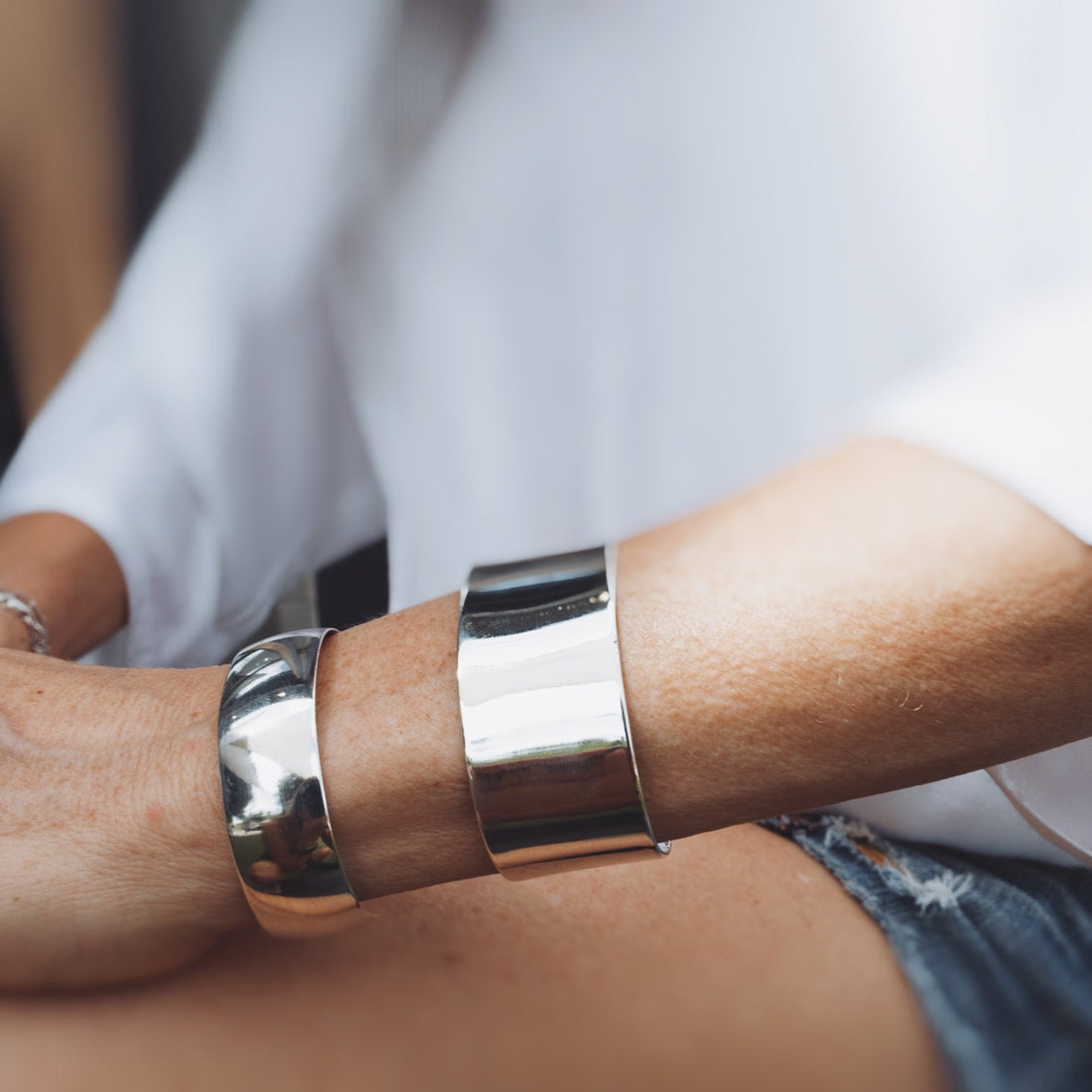
How to Clean Jewelry & Understand Patina vs Tarnish
Share
Keeping your jewelry beautiful comes down to two things: knowing the difference between patina and tarnish, and cleaning each metal the right way. This guide explains what’s happening on the surface of your pieces and how to care for sterling silver, Argentium silver, gold-filled and solid gold, jewelers brass, bronze, and more—so your favorites last for years.
For a deep dive on silver alloys, see our companion guide: All About Silver Jewelry. Curious how water affects your pieces? Read: Jewelry in Water: What to Know.
What Is Tarnish?
Tarnish is a natural surface reaction—usually silver, copper, or brass reacting with oxygen, sulfur, moisture, and everyday products. It appears as dullness or darkening. Tarnish is not permanent damage; it sits on the surface and can be polished away safely when cleaned correctly. Buy a safe jewelry polishing cloth here.
What Is Patina?
Patina is the gradual, often desirable color shift that metals develop over time. On brass and bronze, it creates a warm, vintage tone; on silver, it can add depth in recessed areas. Patina is part of a piece’s character. You can embrace it—or gently polish to brighten the finish.
Patina vs Tarnish: What’s the Difference?
Both are surface changes. Tarnish is typically an unwanted film that dulls shine and is removed during cleaning. Patina is the aesthetically pleasing aging effect many wearers love, especially on brass and bronze. Your care routine decides whether
you keep the patina or polish back to bright.

How to Clean Jewelry by Metal
Sterling Silver (.925)
Use a treated jewelry polishing cloth it removes tarnish without scratching. For a deeper clean, use a mild silver cleaner as directed, then rinse and dry thoroughly.
Argentium Silver
Argentium is more resistant to patina than traditional sterling. Most routine care needs only a soft cloth. If additional cleaning is needed, use a gentle silver cleaner, rinse, and dry.
14k Gold-Filled & Solid Gold
Soak briefly in lukewarm water with a drop of mild dish soap, brush gently with a soft brush, rinse, and pat dry. Avoid harsh chemicals and abrasives. Gold-filled is durable for everyday wear; solid gold typically requires the least maintenance.
Jewelers Brass
Expect patina to develop over time—that’s part of its charm. To brighten, use a treated jewelry polishing cloth or a brass-safe cream polish sparingly. Rinse residue and dry completely. Store in an airtight pouch to slow patina when you want a brighter look.
Bronze
Similar to brass, bronze develops a warm patina. Polish with a soft cloth or a bronze-safe polish when you want more shine. Always rinse and dry thoroughly, and avoid prolonged contact with lotions, perfumes, and saltwater to control surface changes.
Plated Jewelry
Keep dry and clean gently. Use only a soft, dry cloth—avoid liquids and chemical dips that can strip plating. Remove before swimming, showering, or heavy activity.
Natural Stones
Many gemstones are porous or delicate. Wipe with a barely damp soft cloth and dry immediately. Avoid soaking, steam, ultrasonic cleaners, and chemicals unless a jeweler confirms it’s safe for that specific stone.
How to Prevent Tarnish or Maintain Patina
- Store jewelry dry, in airtight pouches or boxes, with anti-tarnish strips.
- Put jewelry on last—after lotions, perfume, hairspray, and SPF.
- Rinse and dry after exposure to sweat, salt, or chlorine.
- Polish selectively: brighten high points, leave recessed areas if you like the patina.
- Rotate daily wear to reduce buildup and micro-abrasion.
Quick Questions Answered
Does water cause tarnish?
Water itself isn’t the only factor, but moisture + air + contaminants speed up surface reactions. Rinse and dry after exposure to pools, oceans, or workouts.
How do I clean tarnished silver jewelry at home?
Start with a silver polishing cloth. If needed, use a mild silver cleaner, rinse, and dry. Avoid harsh abrasives.
Can patina be removed?
Yes, polishing lifts patina and tarnish from the surface. If you love the vintage look, polish less often or only on highlights.
What’s the safest way to clean gold jewelry?
Mild soap, lukewarm water, soft brush, rinse, and pat dry. Skip harsh chemicals and abrasive cloths.
How do I keep jewelry from tarnishing?
Store dry and airtight, minimize chemical exposure, and use anti-tarnish strips. Regular light polishing prevents buildup.
Is sterling silver good for everyday wear?
Absolutely. It’s durable and versatile. Clean periodically and store dry to manage patina.
Does Argentium silver develop patina?
Much slower than traditional sterling. Often a quick wipe restores brightness.
Should I clean brass and bronze the same way?
Yes—use a soft cloth first. For more shine, use brass/bronze-safe polish, then rinse and dry. Decide how much patina you want to keep.
Can I wear jewelry in the shower or ocean?
We don’t recommend frequent exposure. Moisture, salt, and chlorine accelerate surface changes. Learn more: Jewelry in Water: What to Know.
Final Notes
Patina and tarnish are natural parts of a metal’s life. With the right cleaning routine and smart storage, you can control the look and keeping pieces bright or embracing a lived-in glow. A little care goes a long way in keeping your jewelry beautiful for years.
